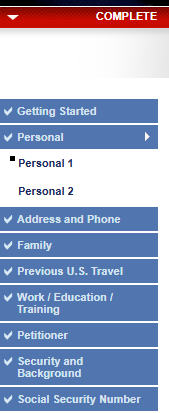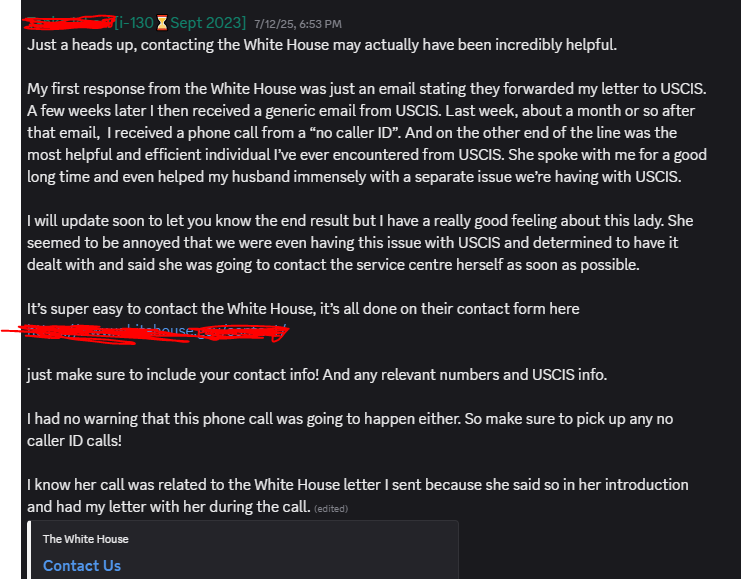-
Posts
116 -
Joined
-
Last visited
Content Type
Profiles
Forums
Partners
Immigration Wiki
Guides
Immigration Forms
Times
Gallery
Store
Blogs
Everything posted by Reynal2m
-
Thanks everyone for your answers. I was reading online that I should first verify what type of business entity my joint sponsor has — whether it’s a Sole Member LLC, a Sole Member LLC taxed as an S-Corporation, or something else — because depending on that, a self-employed person might issue a W-2 to themselves. I’ll check with her accountant to make sure I didn’t miss anything. If this doesn’t apply to her situation, I’ll upload the tax transcripts and a PDF statement explaining that she has no W-2s or 1099s, since she’s self-employed.
-
Hi everyone, I recently submitted all required documents to NVC, and today I received this message: “Please submit every 2024 W-2, 1099, and Schedule from Joint Sponsor.” However, everything else was marked as “Accepted” — the only issue seems to be with this part. My joint sponsor is self-employed and owns a restaurant. I already uploaded her complete 2024 tax return in one 26-page PDF file, which included: Form 8879 (IRS e-file Signature Authorization) Form 1040 and 1040-V Schedule 1 (Additional Income and Adjustments to Income) Schedule 2 (Additional Taxes) Schedule C (Profit or Loss from Business) Schedule E (Supplemental Income and Loss) Schedule SE (Self-Employment Tax) Form 6251 (Alternative Minimum Tax) Schedule EIC, Schedule 8812, Form 8995, Form 8582, Form 8867, Form 4562. So basically, her full tax return is there. But I’m confused because, to my understanding, self-employed people usually don’t have W-2s, and if she didn’t receive any 1099s, there wouldn’t be any to include. Has anyone else gotten this same message from NVC for a self-employed joint sponsor? Are they just requesting clarification that there are no W-2s or 1099s, or should I try re-uploading the 2024 Tax document again (The 26 pages PDF file with all the forms)? Any advice from those who’ve gone through this would be really helpful.
-
DS-260 DRIVING ME CRAZY
Reynal2m replied to Mneforever97's topic in IR-1 / CR-1 Spouse Visa Process & Procedures
There is no ongoing maintenance — this is just how the website normally operates. I was logged out over 100 times before I could complete the form. One possible explanation I received was that the site gets overloaded with users, so it’s best to try during off-peak hours. In reality, though, all you can do is log in again every time it kicks you out. Here are some tips that helped me and may help you save your progress more efficiently: 1. Save your answers in a Word document: Write and store all your answers in a separate document. That way, you can simply copy and paste them into the form each time you log in. 2. Fill out the DS-260 form with minimal answers at first (don’t submit): Start by entering just enough information to allow the system to save each section and continue. For example: For the question asking for all addresses since you were a minor, just enter one address temporarily. Do the same for your education and work history — provide minimal input at first, save it and move on to the next category. This allows the form to save partial data, so you won’t have to start from scratch each time you log in. 3. Navigate using the tabs on the left side of the page: Instead of clicking the “Next” button to move through each section, use the tabs on the left to jump directly to the part you want to work on. For example, if you were logged out while filling out the Family section, don’t click through all the previous pages — just click the “Family” tab to go straight there. This saves time and reduces the chances of being logged out again. 4. Avoid using the “Next” button to return to where you left off after being logged out (This only applies when you have filled out the whole form and you have incomplete sections) Save constantly — every step counts: Make sure to save your progress every time you enter new information. For example, in the Social Media section, if you have Facebook, Instagram, and TikTok, enter one platform, save, then add the next one and save again. It takes patience, but stay persistent — you’ll get through it. -
DS-260 DRIVING ME CRAZY
Reynal2m replied to Mneforever97's topic in IR-1 / CR-1 Spouse Visa Process & Procedures
The system wouldn't let you fill it out if the fees has not been paid and cleared... -
I-864 Question – Using Assets to Qualify
Reynal2m replied to Reynal2m's topic in IR-1 / CR-1 Spouse Visa Process & Procedures
Thanks for the reply. I found a joint sponsor and submitted everything 3 days ago, just waiting for NVC to review the docs. -
I-864 Question – Using Assets to Qualify
Reynal2m replied to Reynal2m's topic in IR-1 / CR-1 Spouse Visa Process & Procedures
Since you have a lot of experience and I’m having difficulties finding a joint sponsor, do you think it’s worth trying without one? If so, what documents would you present? -
I-864 Question – Using Assets to Qualify
Reynal2m replied to Reynal2m's topic in IR-1 / CR-1 Spouse Visa Process & Procedures
In Madrid it normally takes 2-3 months -
I-864 Question – Using Assets to Qualify
Reynal2m replied to Reynal2m's topic in IR-1 / CR-1 Spouse Visa Process & Procedures
Thanks for all your comments. I will give it a try with the assets first and if needed I will get a joint sponsor. -
I-864 Question – Using Assets to Qualify
Reynal2m replied to Reynal2m's topic in IR-1 / CR-1 Spouse Visa Process & Procedures
Yes, this is my residence. How about the US$90,000 on my savings account? -
Hi, I am completing the I-864 as an independent travel agent in Miami, FL. My income for 2024 was $14,000, which is below the poverty guideline for a household of two (myself and the intending immigrant). I would like to know if I can use my assets to meet the financial requirement. For example, I have $90,000 in liquid savings and own an apartment valued at $300,000. If assets can be used, what documentation is required? Would providing the property deed and a bank letter showing that the funds have been held for more than 12 months be sufficient? Thank you for your guidance. Renzo & Reynaldo
-
Withdraw application (Urgent help)
Reynal2m replied to mister-love's topic in IR-1 / CR-1 Spouse Visa Process & Procedures
You’ll still need to have it translated if you plan to submit a petition for your new partner later. There are online translation services available for about $25. -
Considering Online Marriage
Reynal2m replied to artsa22x's topic in IR-1 / CR-1 Spouse Visa Process & Procedures
For USCIS purposes, she is not required to change her last name, and there is no need to register it in the Philippines. -
Annotation on my cr1 visa
Reynal2m replied to JJMC's topic in IR-1 / CR-1 Spouse Visa Process & Procedures
Excellent! Glad to hear, thanks for sharing. -
Hi, Hope you're doing well. Did you end up refiling? I came across a post on another forum where someone had a similar issue—their I-130 was denied due to an incorrect signature. They mentioned filing a motion to reopen and then submitting a new I-130. Apparently, they included the denial notice as supporting evidence with the new petition and were approved fairly quickly. I'm not very familiar with the process myself, but thought it might be helpful to pass this along. Best regards,
-
We totally understand how you feel—we’re in the same boat. We’ve been waiting 16 months, and it’s painful to see others who filed the same day, (even earlier), already get approved. What makes it even harder is knowing there’s a backlog at our embassy, with interview wait times over a year. So even if USCIS finally approves us, we’re still looking at more than a year before we can even try to reunite in the U.S. After reviewing various recommendations online, I wanted to share a few strategies that have reportedly helped others in similar situations: Contact a Tier 2 USCIS officer – This can sometimes provide more detailed information or trigger movement on your case. Upload unsolicited evidence – Refile or submit Form I-129F (K-3 visa) – Reach out to your Senator and House Representative – Especially if you submitted a K-3 inquiry (this typically helps with the K-3, not the I-130 as they will say it's under normal timeframe). Write to the White House – Yes, really. Surprisingly, some people have received responses or seen progress after doing this. Send a letter to the Department of Homeland Security (DHS) – Another way to raise awareness of your case at a higher level. File a CIS Ombudsman case assistance request – Helpful when your case is outside normal processing times and USCIS isn’t responding. As a last resort: File a writ of mandamus – This is a federal lawsuit to compel USCIS to make a decision when they’ve unreasonably delayed action. We wish you the best of luck and hope you receive an update from USCIS very soon. Warm regards, Reynaldo and Renzo
-
Best advice: I was denied a Spain visa back in 2021, so I decided to focus on traveling to other countries instead. I visited Colombia three times (had a blast!), went to Panama twice, and also traveled to Turkey and the UAE. When I finally reapplied for a Schengen visa, the officer at the interview noticed my travel history, commented that I travel a lot, and said she liked my profile—she approved my visa on the spot. Since then, I’ve successfully obtained two Schengen visas. Japan sounds very fun...
-
Annotation on my cr1 visa
Reynal2m replied to JJMC's topic in IR-1 / CR-1 Spouse Visa Process & Procedures
Put your question into ChatGPT and got a detailed explanation: Yes — that notation on your visa/green card refers to a medical classification and public health review requirement at your port of entry (POE) into the U.S. Let’s break it down: 🟡 “Class B” Medical Condition This refers to a medical condition that is not inadmissible, but still requires attention or monitoring. Class A: Serious medical conditions that could make someone inadmissible without a waiver. Class B: Less serious — does not prevent immigration, but requires follow-up after entry. 🟡 "req attn of USPHS at POE" USPHS = U.S. Public Health Service POE = Port of Entry This means that when you arrive in the U.S., Customs and Border Protection (CBP) officers may refer you to a CDC (Centers for Disease Control) or USPHS medical unit at the airport or border crossing for further evaluation or instructions related to your medical condition. 🟡 212(g)(2)(B) This is a reference to Immigration and Nationality Act (INA) Section 212(g)(2)(B). It allows individuals with certain communicable diseases or health conditions to be admitted to the U.S. under conditions, such as reporting to U.S. health authorities. 🔍 Most Common Scenario This notation is commonly used for applicants who: Tested positive for TB (tuberculosis) screening but were not infectious Had Class B1 TB, meaning inactive TB, or old scarring from past TB Had other chronic conditions that aren’t grounds for denial but require follow-up ✅ What You Should Do At your POE, CBP may refer you to a CDC officer. You might receive instructions or a packet to give to a local health department. You may be required to attend a free follow-up medical appointment within 30 days of entry. 🟢 Important: This Does Not Affect Your Immigration Status You can still enter the U.S. and activate your green card. The note is only a health follow-up requirement, not a denial or restriction. -
CR1 for my fiancé while I'm deployed
Reynal2m replied to xyang410's topic in IR-1 / CR-1 Spouse Visa Process & Procedures
When you apply online for a Utah marriage license, the license has to reflect your current legal name exactly as it appears on your government-issued ID. The system pulls that information directly from the ID you provide, and there's no option to enter a new married name during the application process. Also, Utah marriage documents don’t include any section for selecting or declaring a new last name. However, once your marriage is recorded and you receive the certified marriage certificate, you can use it to update your last name with places like the Social Security Administration (SSA), the Utah DMV, your passport, banks, employers, and so on. -
CR1 for my fiancé while I'm deployed
Reynal2m replied to xyang410's topic in IR-1 / CR-1 Spouse Visa Process & Procedures
Ok, thanks for clarifying







